- MODFLOW-Farm Process Modeling for Determining Effects of Agricultural Activities on Groundwater Levels and Groundwater Recharge
Kedir Mohammed Bushira1*·Jorge Ramírez Hernandez2
1Corresponding author: Department of Water Resources and Irrigation Engineering, P. o. Box 21, Arba Minch University, Ethiopia
2Instituto de Ingeniería, Universidad Autónoma de Baja California, Mexicali 21280, Baja California, Mexico
Intensive agricultural development in Mexicali valley, Baja-California,
Mexico, has induced tremendous strain on the limited water resources.
Agricultural water consumption in the valley mainly relies on diversions of the
Colorado River, but their water supply is far less than the demand. Hence, the
use of groundwater for irrigation purposes has gained considerable attention.
To account for these changes, it is important to evaluate surface water and
groundwater conditions based on historical water use. This study identified the
effects of agricultural activities on groundwater levels and groundwater
recharge in the Mexicali valley (in irrigation unit 16) by a comprehensive
MODFLOW Farm process (MF-FMP) numerical modeling. The MF-FMP modeling results
showed that the water table in the study area is drawn downed, more in eastern
areas. The inflow-outflow analysis demonstrated that recharge to the aquifer
occurs in response to agricultural supplies. In general, the model provides
MF-FMP simulations of natural and anthropogenic components of the hydrologic
cycle, the distribution and dynamics of supply and demand in the study area.
Keywords: Mexico, MODFLOW farm process, Agriculture, Groundwater level, Groundwater recharge
The
determination of surface water and groundwater allocations to farms is
desirable for legal requirements (e.g. Stream volume adjudications), and for
agro-economic decision making ahead of the growing season. The need to specify
these flow rates applies to historic and future time intervals (Schmid W.
2004). In Mexico groundwater already represent 38% of total annual water
withdrawal and agriculture represents over three-fourths of the total
groundwater withdrawal at national levels.
The Baja
California-California border region is bounded by a common geography
characterized by its booming population, scarce water supply, and arid land.
The natural rivers of this region are among the most regulated, used, and
contaminated waterways in the world. These rivers are currently used to the
extent that they often no longer discharge to their respective termini, i.e.
the Colorado River, whose billions of cubic meters of annual flow no longer
reach, the Gulf of California. This situation is largely driven by upstream
diversions and economic forces that make the border region one of the most
productive geographic regions in México. This is also one of the driest regions
in Mexico and its explosive growth has put tremendous strain on the limited
water resources. Agriculture in the Mexicali Valley withdraws approximately
2.5*109 m3 of water annually (Roman-Calleros and
Ramírez-Hernández, 2003). Pumping of groundwater for supplementary irrigation
in the Valley has reduced groundwater levels significantly in some areas.
Increased groundwater use had induced leakage from rivers and canals to
groundwater, which has become the predominant form of surface water and
groundwater interaction. Surface water and groundwater are highly connected due
to the sandy nature of the alluvial aquifer in the Valley.
To help
sustainably manage and conjunctively use these resources, there is needed to
gain a better understanding of water movement in the hydrologic system through
hydrologic modeling.
MODFLOW Farm
Process (MF-FMP) is a unique and versatile alternative that provides fully
coupled, cell-by-cell distributed fully iterative simulation of
supply-constrained and demand-driven conjunctive use and movement of water from
natural and anthropogenic sources.
The
alteration of the Colorado River delta of wilderness, to the highly productive
agricultural region that exists today in U.S.A-Mexico border region, brings
many questions and presents an excellent subject for a groundwater modeling
study. How has the aquifer beneath the Colorado River delta responded to the
agricultural expansion when the Colorado River water is changed from natural
flow to scheduled releases?
The main aim of this study was (1) to investigate the
effects of agricultural activities on groundwater level and groundwater recharge
and (2) to evaluate the sources of irrigation water in user-defined water
balance subregions (WBS) of commonly known by Irrigation Unit 16 (Fig. 1) over
12 years using MODFLOW Farm Process (MF-FMP). The stress packages in MF-FMP,
among others, employed are; the Unsaturated
Zone Flow (UZF1), Stream Flow Routing (SFR), well package
(WEL) and Drain package (DRN).
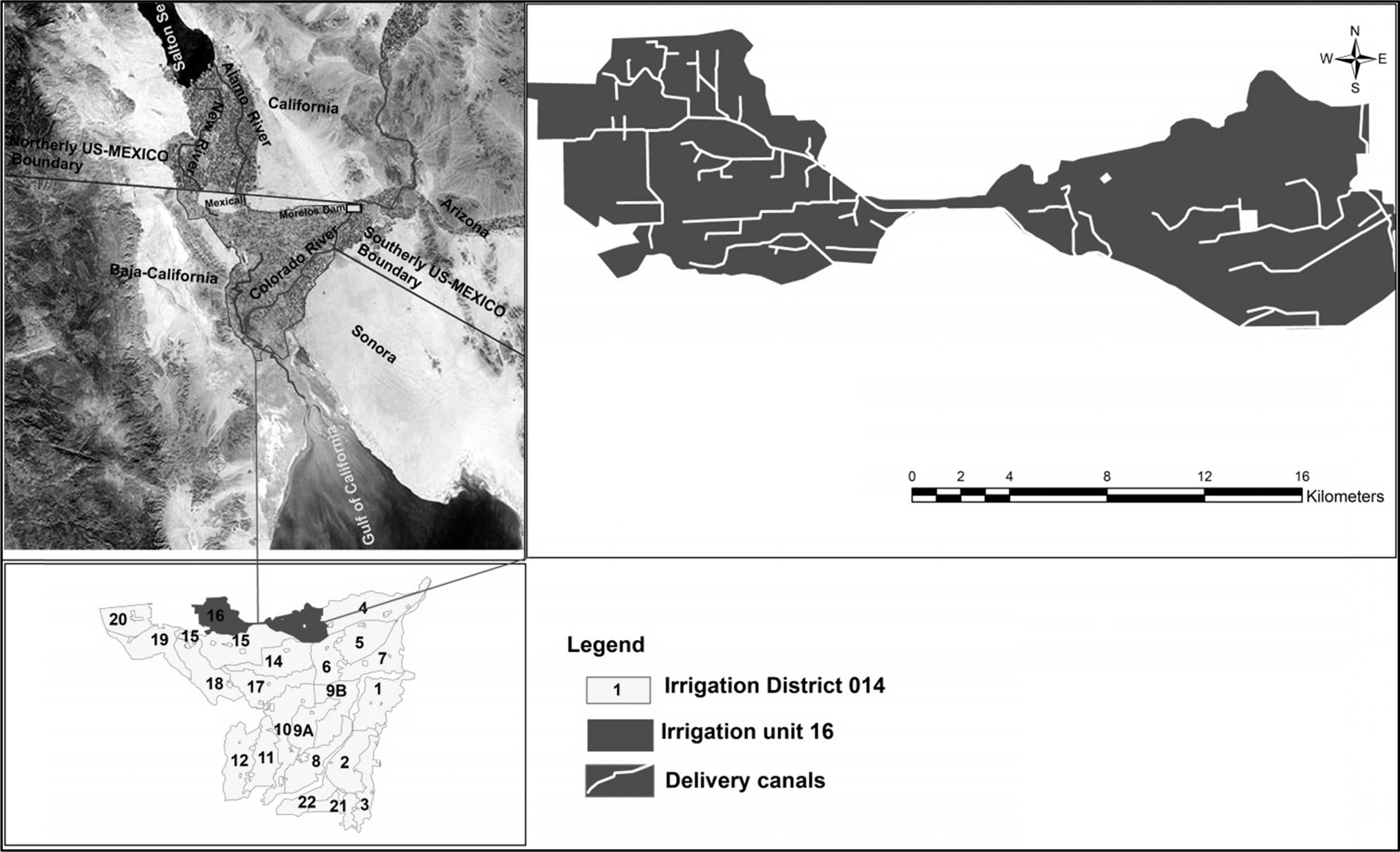
|
Fig. 1 Location map of the study area (irrigation unit 16). |
The Farm
process (Schmid et al. 2006a, 2006b; Schmid and Hanson 2009a, 2009b) for
MODFLOW-2005 (Harbaugh 2005) (MF-FMP) was developed to provide detailed
hydrologic budgets for all or part of a hydrologic system and to examine how
such budgets change over time. Conservation equations for groundwater, stream,
lake, root zone, and land-surface runoff processes are solved simultaneously to
simulate a large portion of the hydrologic cycle, and the agronomic and human
effects on the cycle. Among the mass conservation equations, the
groundwater-flow equation (1) is the governing equation that is solved for
groundwater heads.
where h, is groundwater head (L), Kh and Kv
are horizontal and vertical hydraulic conductivity (LT−1),
respectively, W is volumetric flux per unit volume representing sources and/or
sinks, x and y are horizontal co-ordinates (L), z is vertical co-ordinate (L)
and t is time (T).
MF-FMP
represents the components of evaporation and transpiration derived from
precipitation, irrigation, and groundwater on a cell-by-cell basis within
user-defined water-balance subregions (WBS). MF-FMP considers two types of
water budgeting for the control volume horizontally delineated by land surface
areas, called “farms”. These water-accounting units can include irrigated and
non-irrigated farms, native vegetation, and urban areas. Using the term “farm”
in MF-FMP” has become somewhat of an anachronism as MF-FMP has advanced to
types of water-accounting units other than just agricultural farms. The water-accounting
units in MF-FMP; do not include changes in soil-water storage and, hence, are
control interfaces at the land surface.
For a given
computational unit; a particular land use area in a given cell, the general
mass-balance equation that MF-FMP is based on for the root zone is the
following: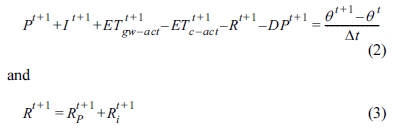
Where P is precipitation (LT-1), I is
irrigation water (LT-1), ETgw-act
is root uptake from groundwater (LT-1), ETc-act
is the total actual crop evapotranspiration (LT-1), R is the
runoff from precipitation and irrigation (LT-1), Rp is the
surface runoff from precipitation (LT-1), Ri is the
irrigation surface return flow (LT-1), DP is the
deep percolation that leaves the root zone as the moisture moves downward
(LT-1), θt+1 is the
soil moisture at the end of a time step (L), ![]() is the
soil moisture at the beginning of a time step (L), Δt is the time step length
(T), and t is the time step index (dimensionless).
is the
soil moisture at the beginning of a time step (L), Δt is the time step length
(T), and t is the time step index (dimensionless).
MF-FMP
computes R as the portion of crop-inefficient losses from precipitation or
irrigation that contribute to runoff:
Where, ETp-act and ETi-act are the portions of the
ETc-act fed by precipitation or irrigation (LT-1),
respectively, and frp –loss and frI– loss are
fractions of the respective crop-inefficient losses from precipitation or
irrigation that go to a runoff, given as time series data.
MF-FMP
computes deep percolation (DP) as the sum of deep percolation below the root
zone from precipitation and irrigation, which can be instantaneous or delayed
with linkage to the unsaturated zone infiltration package, UZF (Niswonger et
al, 2006). It is the user-specified portion of losses of precipitation and
irrigation that are not consumptively used by plants and not lost to surface
water runoff:
The current
version of MF-FMP does not consider changes in soil-water storage in the root
zone (i.e., RHS in equation (2) = 0):
MF-FMP still
takes into account that the root zone might be inactive for conditions of
wilting or anoxia. However, for any head between the lower and upper extinction
depths, MF-FMP derives transpiration from groundwater; the residual crop water
demand is then satisfied by transpiration from precipitation or irrigation.
That is, at a steady state of soil moisture, ETc-act of equation (7) can be
split into six components from three sources: groundwater, precipitation, and
irrigation (Tgw-act, Egw-act, Tp-act, Ep-act, Ti-act, Ei-act,). All 6
components contribute to ETc-act However, Tp-act, Ep-act, Ti-act, and Ei-act
are outflows out of the landscape budget. In contrast, some parts of Tgw-act
and Egw-act are inflows from GW into the root zone (landscape budget) but also
outflows from the root zone into the atmosphere.
3.1. Study area
The State of
Baja California is located to the Northwest of Mexico, bounded on the north by
the State of California, USA, to the east by the State of Sonora, Mexico, to
the west by the Pacific Ocean and south by the State of Baja California Sur
(Fig. 1).
Within the
limits of the State of Baja California and Sonora, is located the section of
the Colorado River corresponding to Mexico, where the territorial boundary
between the two States, which begins its journey in the dam diverter Jose Maria
Morelos up reach the Gulf of California. The Colorado River Delta is one of the
world’s largest deltas covering over 8,600 km2 of terrain and
extending across the international border between the United States (U.S.) and
the Republic of Mexico (Mexico). The Delta developed as a result of the
constructive processes of sediment transport by the Colorado River and the
destructive processes associated with, 1) the large tidal regime dominated by
strong currents in the upper Gulf of California and, 2) tectonic movement along
the San Andreas Fault, which has transported sediment NW across the Delta over
millennia (Sykes 1935).
Irrigation
District 014 (Fig. 1) is divided into 22 irrigation units or irrigation
administrative areas, for which pumping and irrigation data are aggregated and
maintained by the National Water Commission of Mexico (CONAGUA). The study
area; the irrigation unit 16 (Fig. 1) service areas encompass about 20,100
hectares, of which about 85 percent is used for agriculture and, 15 percent is
primarily urban land. Elevation in the study area ranges from about 41 m
in the northeast to less than 5 m to south.
The Mexicali
Valley is characterized by a desert climate dominated by high temperatures and
arid conditions. The valley’s climate is defined by clear skies and plenty of
sunlight, with little precipitation given the atmospheric dominance of high
pressure. Average monthly high temperatures in July are 42oC and the
lowest average monthly high of 21oC occurs in December. The yearly
average precipitation is 72.5 mm, with monthly average precipitation
values averaging 0 mm in June and 12.4 mm in January.
3.2. Geology and Hydrogeology
There are
around five topographical areas in the Gulf of California: (1) the cutting edge
subaerial Salton Trough, (2) North Gulf Region, (3) Central Gulf Region, (4)
South Gulf Region, and (5) Gulf Mouth Region. During the Early to Middle Miocene
(24 to 11 Ma), an earthbound volcanic bend was shaped along what is currently
generally the hub of the advanced Gulf of California (Hausback 1984; Sawlan and
Smith 1984). Those volcanic rocks comprise the storm cellar for the Gulf
Extensional Province (Gastil et al. 1973). They make due as mountains made out
of thick andesite streams circumscribing the western side of the inlet in
peninsular Baja California (Fig. 2). More youthful volcanism began around
13 Ma in eastern Baja California and inside the creating Gulf of
California crack. An examination of a multiple of well logs very near to the
study area demonstrate
that, there is unconsolidated irregular sequences of clay, sand, gravel and mud persist in area
for at least 180 m below the land surface (Feinstein et al., 2008).
Soils in the
valley are generally classified under the principle soil order of Aridisols,
according to the soil taxonomy developed by the United States Department of
Agriculture (USDA). The defining characteristics of such soils are their lack
of sufficient moisture for mesophytic plants and limited soil horizon
development. Entisols are also present in the valley given its original
formation as the floodplain of the Colorado River (Hillel 2008). While
localized variations do exist across the valley, the soil texture is generally
a sandy clay loam, with limited areas on the western edge of the valley having
a greater concentration of clay as a result of erosion associated with the
Sierra Cucapa and Sierra Mayor mountains.
The aquifer
system is divided into two parts: the upper fine-grained zone and wedge zone
and coarse gravel zone (Olmsted et al. (1973). In the valley, the uppermost
sediment varies spatially and include coarse alluvial piedmont sand and gravel
sediments derived from the Sierra Cucapah, which dominate in the south west
(SW) (Puente and De La Pena 1979), and fluvially transported fine, medium, and
coarse-grained sediments of clay, sand, and gravel which dominate in the east
(Pacheco et al. 2006; Sykes 1935).
Transmissivity
values for the upper fine-grained zone were determined to be 150–930 m2/day
Hill (1993). A storage coefficient of 10−3 and a specific yield of
between 0.18 and 0.35 were estimated (Hill 1993). The Wedge zone (120 m to
680 m below the upper fine zone) is considered single heterogeneous
water-bearing hydraulic unit composed of irregularly layered sands, gravels,
silts, and clays (Olmsted et al., 1973). The coarse gravel zone overlies the
Wedge zone and is a highly permeable water-bearing unit composed primarily of
irregularly layered coarse gravel and sand. This unit constitutes the main
pathway for horizontal groundwater flow in the system (Mock et al., 1988).
Together the wedge
zone and coarse gravel zone may represent what is described in research of the
modeled Colorado river area area (i.e. Pacheco et al., 2006; Portugal et al.
2005; Chavez et al. 1999; Barragan et al., 2001) as the upper sediments of the
Mexican Colorado River delta basin with a composition of fluvial and alluvial
not- consolidated sediments of Pleistocene to Recent ages. Transmissivity
values for the Wedge zone and Coarse Gravel zone combined were determined to
range from 835 to 22,300 m2/day (Olmsted et al. 1973).
Horizontal hydraulic conductivity was calculated to range up to 400 m/day.
Vertical hydraulic conductivity, storage coefficient, and specific yield were
determined equal values to the upper fine-grained zone; the primary sources of
groundwater in the delta are infiltrated Colorado River water and agricultural
irrigation (Hill 1993). Surface water is also transmitted in the area via
canals, drains, and the main tributary of the Colorado River; the Rio Hardy.
3.3. Conceptual model
MODFLOW farm
process (MF-FMP) (Schmid et al. 2006a, 2006b; Schmid and Hanson 2009a, 2009b)
with ModelMuse Graphical User Interface (GUI) (Richard B. Winston.2009) was
used to determine the effects of agricultural activities on groundwater at
irrigation unit 16 and also to determine the surface-water and groundwater
allocations to farms, including components of evaporation and transpiration
derived from precipitation, irrigation, and groundwater within the selected
water-balance subregions (WBS); Results of WBS1 and WBS 3 are presented and
found at the end of this article.
The model
(Fig. 3) was constructed using uniform grid cells of 250 m by 250 m
and the water balance subregions (WBS) are found in Fig. 4 (I). The active grid
network has 49 rows and 130 columns with a total of 2962 grid cells. It was
aligned with the coordinate system of WGS-1984-UTM-zone-11-N. The regional
stratigraphy was conceptualized in two layers. The first layer has a thickness
of 120 m from the ground surface (upper fine-grained zone) and the second
layer (a combination of wedge zone and course gravel zone) has a thickness of
680 m. To hydraulically characterize the hydrogeological units in the
model area, data were reviewed on Transmissivity, specific storage and storage
coefficient from a previous parent MODFLOW model study (Bushira. K. M, et al.,
2017) and others (Feinstein et al., 2008; Rodriguez-Burgueño, 2012). The degree
of permeability in the first layer, in the horizontal directions (Kh,)
is spatially differentiated which contain two zones of hydraulic conductivity
(Fig. 3). The specific yield of Layer 1 was a constant value of 0.2. Vertical
hydraulic conductivity (Kv) in Layer 1 was 0.03 m/d. Layer 2 has an
identical footprint to layer 1 and was designed to reflect a simplified
state-of-knowledge of the model area geology. This layer represents the less
hydrologically significant thick lower unit of consolidated to semiconsolidated
mudstone- siltstone and well-sorted sandstone of marine and continental origin
as described by other workers in the area. Layer 2 was designated a uniform
(Kh) of 0.001 m/d and specific storage of 0.00003 1/m. Vertical
hydraulic conductivity in layer 2 was assigned a value of 0.03 m/d.
Throughout
the model, the units of measurements are set to meters for length and days for
a time. The time frame of the model simulation is 12 hydrologic years from 1st
October 1995 to 30th September 2006.
3.4. Landscape Attributes
The
assessment of sustainable yield and analysis of the supply and demand
components relative to the hydrologic cycle requires discretization of the
irrigation unit 16 into subregions that can be used to estimate the water
balance of land use and groundwater. In this study, the WBSs are hydrologic entity
delineated farm groups that are used to calculate the overall supply and demand
components through time. Irrigation unit 16 was grouped into 6 water balance
subregions (Fig. 4). These subregions represent a combination of virtual farms
in the unit that can be used to assess the inflow and outflow components of the
hydrologic cycle. This article presents the results of simulated
supply-constrained and demand-driven components across the landscape for WBS1
on the eastern side and WBS3 on the western side (Fig. 4).
The main
types of crops grown in irrigation district 014 are wheat (65%), alfalfa (19%),
and cotton (8%). The main crops in the study area; irrigation unit 16 are wheat
and alfalfa (Yamilett K.C. G 2009). The information used in the study area regarding
the main types of crop and their properties for MF-FMP modeling were identified
(Table 1 and Table 2). These values are derived from the literature and from
related studies (Schmid and others, 2006a).
The
irrigation efficiency for the study area was reviewed from previous studies
(Eliana, et al., 2012 and Feirstein et al. 2008); an efficiency value of
0.65 to 0.85 is adopted in this study.
Four
categories of soil are identified in the study area (Fig. 4). The spatial
locations and distributions of crop types, soil types and water balance
subregions (farms) were pre-prepared as an object shapefile in ArcGIS and
exported to ModelMuse, a different soil, and farm id was assigned (Fig. 4). The
drains of the irrigated agriculture were simulated with the drain package in MODFLOW.
The drain package for the study area was used and the drains set a specified
drain elevation that is about 1.8 m below the land surface of drainage model
cells (Fig. 4(III)) that are generally coincident with the regions identified as
having drains. The remaining border area was analyzed using general head
boundary (GHB) (Fig. 4(III)).
3.5. Surface water and Groundwater Agricultural Supply
Surface-water
inflows and outflows were simulated with a streamflow routing network composed
of 55 stream segments representing the delivery canal which delivery surface
water from the Colorado River into the irrigation unit 16. This network (Fig.
4(IV)) was used to simulate the inflows and outflows along the major
diversions. These features were simulated using the Streamflow-Routing Package
(SFR2; Niswonger and Prudic, 2005); this head-dependent boundary condition
allows for streamflow routing and the conveyance of overland runoff and the
diversion of water for irrigation.
Groundwater
pumpage is a major component of the hydrologic budget in Mexicali Valley and is
used for agricultural water supply. Irrigation district 014 which shares the
same aquifer with irrigation unit 16 includes more than 639 pumping wells used
to supply water for irrigation. All Farm wells are located in the first layer;
simulated as a single-aquifer well (Schmid and others, 2006a) that collectively
supply water needed for irrigation for each WBS. Farm wells that are
single-aquifer wells are simulated using the WEL package (Harbaugh and others,
2000) and the total pumpage for each WBS (that is, virtual farm) is distributed
among each of the farm wells within the WBS based on the fraction of total
pumping capacity (Schmid and others, 2006a). A total of six groundwater wells
are found in irrigation unit 16 which is located on the eastern edge on WBS 1
and WBS2.
The
simulated temporal distribution of hydraulic head for the whole irrigation unit
16 was used to identify the effects of agricultural activities on groundwater
level and the water budget was used to detect groundwater recharge. In
addition, the recharge to the aquifer was determined by analyzing the water
budget for each water balance subregions (virtual farms). In this article, the
landscape budgets for WBS1 on the eastern side and WBS3 on the western side are
presented.
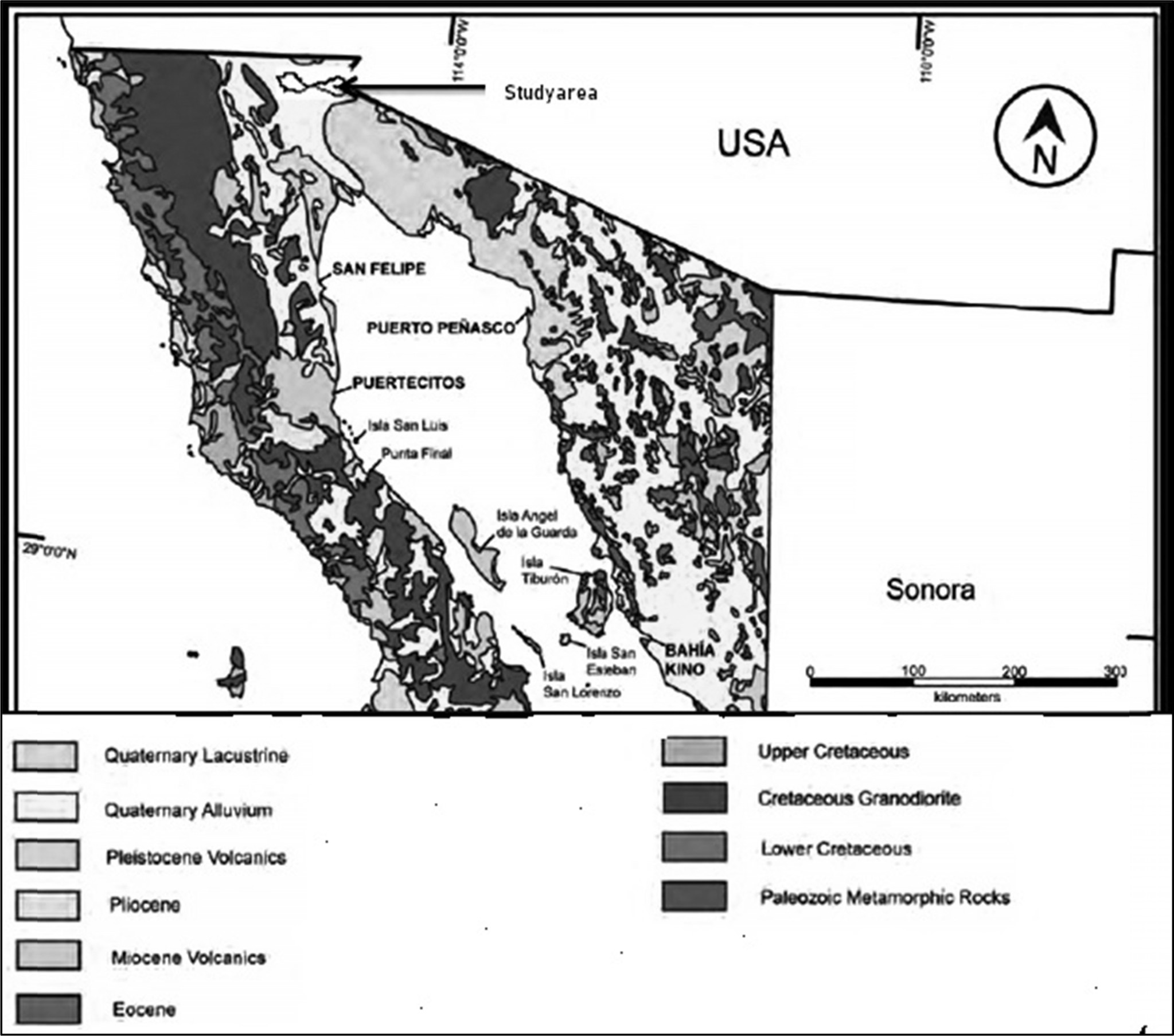
|
Fig. 2 Geological map of the Baja California North. The study area is showed by an arrow in U.S.A Mexico border region. |
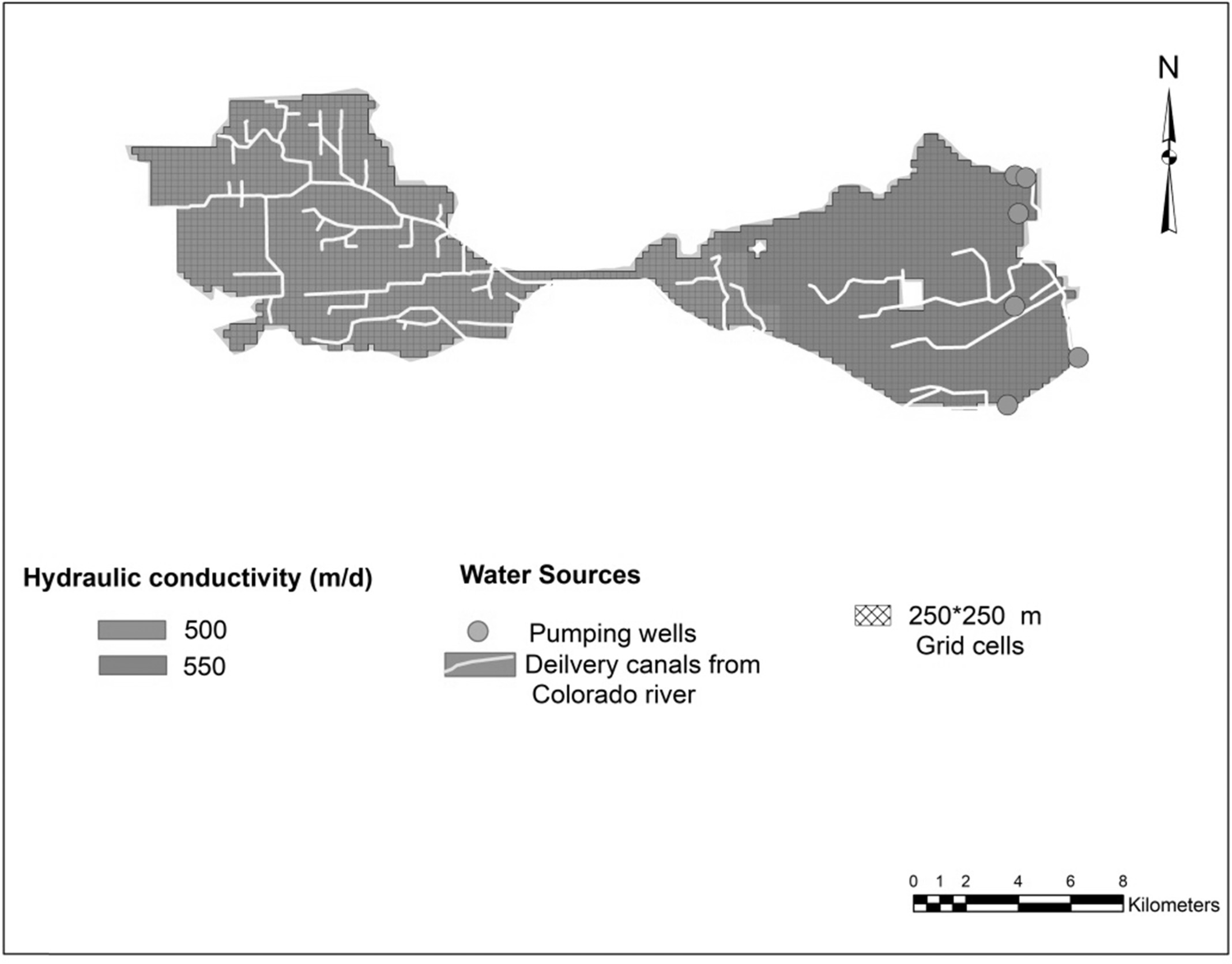
|
Fig. 3 Distributions of calibrated horizontal hydraulic conductivity (Kh) for the 1st layer, water sources, and grids used for MF-FMP modeling. |
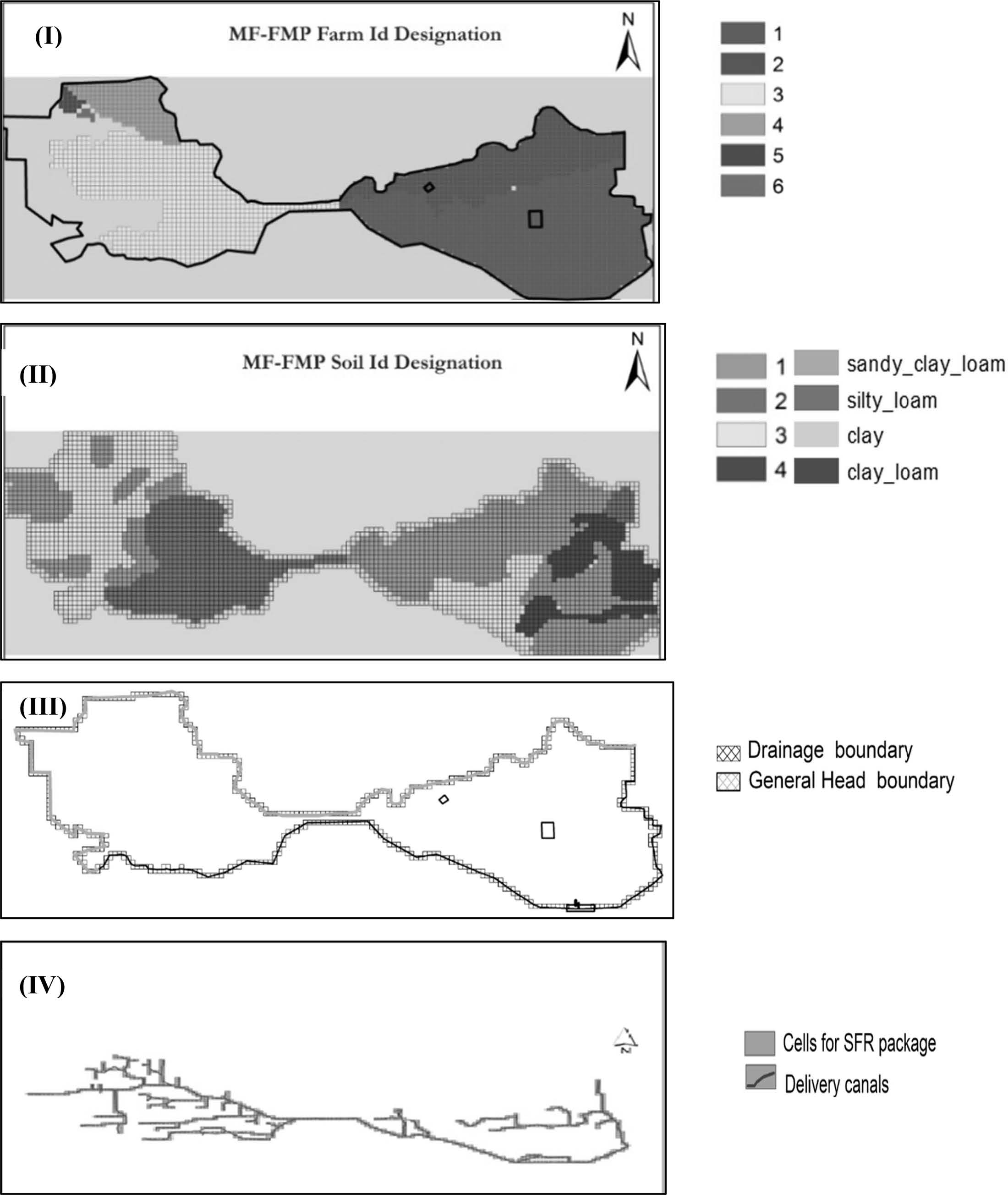
|
Fig. 4 (I) WBS and WBS id designation, (II) soil distribution and soil id designation, (III) boundary conditions and (IV) distributions of delivery canals for streamflow routing package (SFR). |
|
Table 2 Summary of fractions of transpiration and evaporation by year for irrigation unit 16 crop categories (virtual crops) |

4.1. Model calibration
The trial
and error basic head calibration was conducted using the available observation
points. Resulting values of the horizontal hydraulic conductivities for the
first layer after calibration are given in Fig. 3. The performance of the
calibration is illustrated by comparing simulated versus observed groundwater
heads. In view of the available head observation points, the result obtained is
fairly acceptable, with an RME (root mean square error) of 0.02 m, a
normalized RMS of 2.1% and a correlation coefficient of 0.97.
Reported
(measured) pumpage for the period 1995 through 2006 was available for WBS1 and WBS2. The totals
of reported agricultural pumpage were compared with agricultural pumpage
estimated through the simulation of water consumption by the Farm Process used
in the study area. The reported agricultural pumpage located at WBS1 and WBS2
were used as additional calibration targets.
Simulated
and reported total agricultural pumpage are compared for the 2 WBSs (Fig. 5).
The model slightly overestimates agricultural pumpage. The percentages of total
reported and simulated agricultural pumpage by WBS are also comparable, within
a few percent, for the two subregions. The annual total and total agricultural
pumpage (Fig. 5) are comparable between reported and simulated values for these
12 years. For the WBS1 and WBS2 model, the average annual differences (reported
minus simulated) for total agricultural were -671 m3/yr. and
-570 m3/yr. for the period 1995–2006, respectively. This
represents average differences of about -0.54 and -0.49 percent of the reported
agricultural pumpage, respectively. These results show that the simulated
pumpage is within the range of uncertainty of the reported pumpage.
The resulting groundwater balance is given in Table 3.
The source of water to the groundwater reservoirs in the study area is through
agricultural recharge, which amounts in total to 97.84*104 m3.
Leakage from the stream which amounts 2.10*104 m3
and lateral inflows which amount 1.08*104 m3 are
other components of inflows. About 2.52 *104 m3 of
groundwater drains out of the system. The study area experiences high
groundwater evaporation amount about 123.16*104 m3.
The model balance error is very small, i.e. -0.71%,
which shows that the model has converged accurately. The discrepancy is
negative; indicating that outgoing groundwater from the study area is higher
than incoming groundwater (recharge) which shows aquifer drawdown.
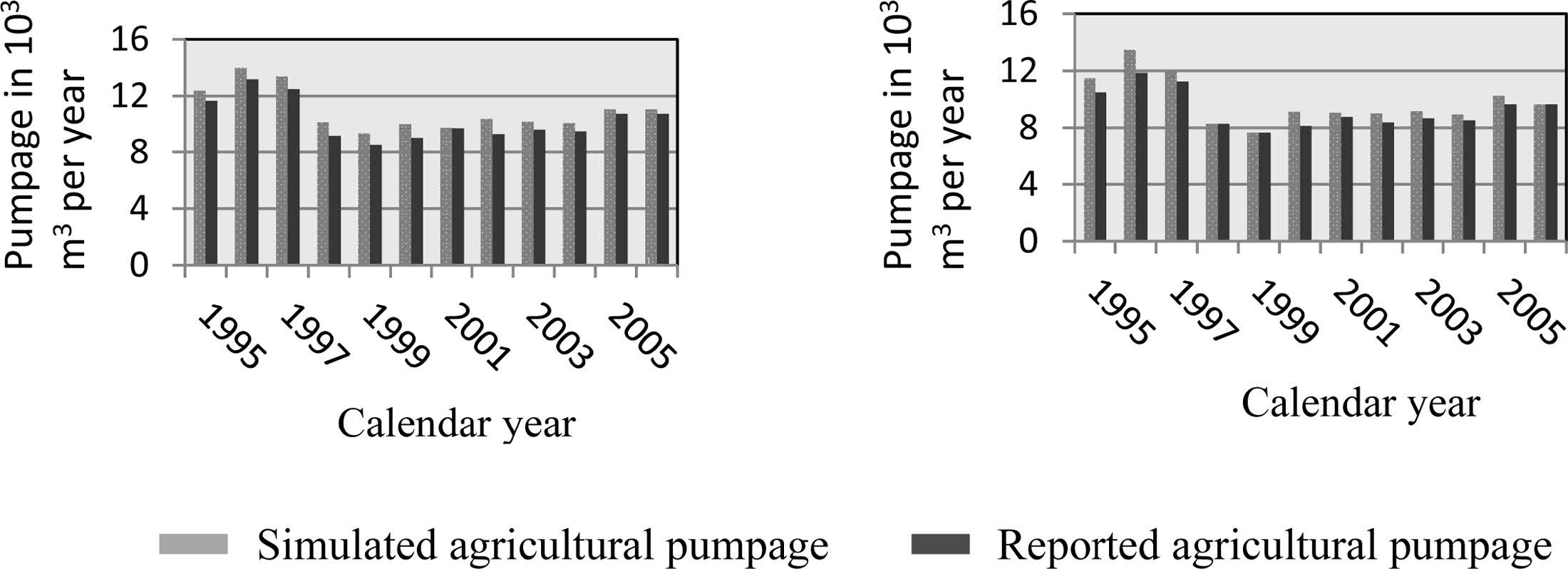
|
Fig. 5 Total annual reported and simulated agricultural pumpage for WBS1 (right) and WBS2 (left) for the period (1995-2006). |
|
Table 3 Groundwater balance obtained from the MF-FMP model (whole irrigation unit 16) |

As indicated
by the simulated potentiometric level (Fig. 6), groundwater flows laterally
from the highest elevation points to the lowlands toward the Gulf of
California. Simulated water levels range from 19.6 m in the highland areas
to less than 10 m in the lowland. The three-dimensional modeling of
groundwater in the study area shows aquifer drawdown for the study period. The
drawdown map (Fig. 6) shows a drawdown ranges from 3 m to 0.3 m. The
drawdown is higher in the northeastern modeling area which is expected because
most of the groundwater pumping wells existed nearby.
Figure 7
shows the simulated total farm delivery requirement for irrigation for a WBS1
and WBS3 for the 12- year period from 1995 to 2006 and Figure 8 summarizes the
overall 12-year WBS landscape hydrologic budgets for WBS1 and WBS3.
The results
show that WBS1, which constitutes the eastern part of the modeling area,
receives comparably more runoff and after the year 1999, lesser recharge than
WBS3, which constitutes the western part of the modeling area. The simulated
total farm delivery requirement (TFDR) shows that TFDR for WBS1 is fulfilled by
73% from the diversion of the Colorado River through delivery canals and 27%
from groundwater pumping. In contrast, the TFDR of WBS3 mainly depends on the
diversion of the Colorado River. There is a significant component of
evapotranspiration (ET) derived from irrigation in both water balance subregions
(Fig. 7, yellow color).
The
simulated component for WBS 1 and WBS 3 (Fig. 7) show that groundwater recharge
is derived from agricultural supplies nothing that the precipitation is lost
due to evapotranspiration.
Fig. 7 also demonstrates a reducing trend recharge.
Groundwater-level
decline and related storage depletion are occurring in this area as
evapotranspiration (ET) from groundwater uptake are about 3% and 4% (Fig. 8,
inflow) and recharge to the groundwater is about 19% and 21% on the landscape
(Fig. 8, outflow) for WBS1 and WBS 3 respectively. Evapotranspiration from
groundwater, water from agriculture wells and routed surface water deliveries
supplement the crop consumptive use for WBS1 and the crop consumptive use of
WBS 3 is supplemented by surface water deliveries and evapotranspiration from
groundwater (Fig. 8).
For each WBS
represented by many model cells, the results shown in Figures 6 to 7 are the
aggregate of the cells involved. Crop types, crop coefficients, potential or
specified evapotranspiration, and other characteristics are defined for each
cell, and results such as crop irrigation requirements are simulated for each
cell.
Integrated
hydrologic models are essential in the analysis of conjunctive use issues; if
not, it might be difficult to analyze the flows and interactions between the
head and flow-dependent components. MF-FMP is one of the integrated hydrologic
models able to simulate coupled processes across the landscape, surface water and groundwater
components of the hydrologic cycle.
This study
shows how WBS can be used to organize input data and simulated results. Farm
process (FMP) input files was easily constructed, updated, and maintained using
soil, well, and crop data that did not require substantial external estimation
of inflows and outflows (pumpage, recharge, evapotranspiration, runoff, surface
water deliveries, etc.) prior to simulation. Because these hydrologic
components are simulated separately, the flows and movement were easily
analyzed.
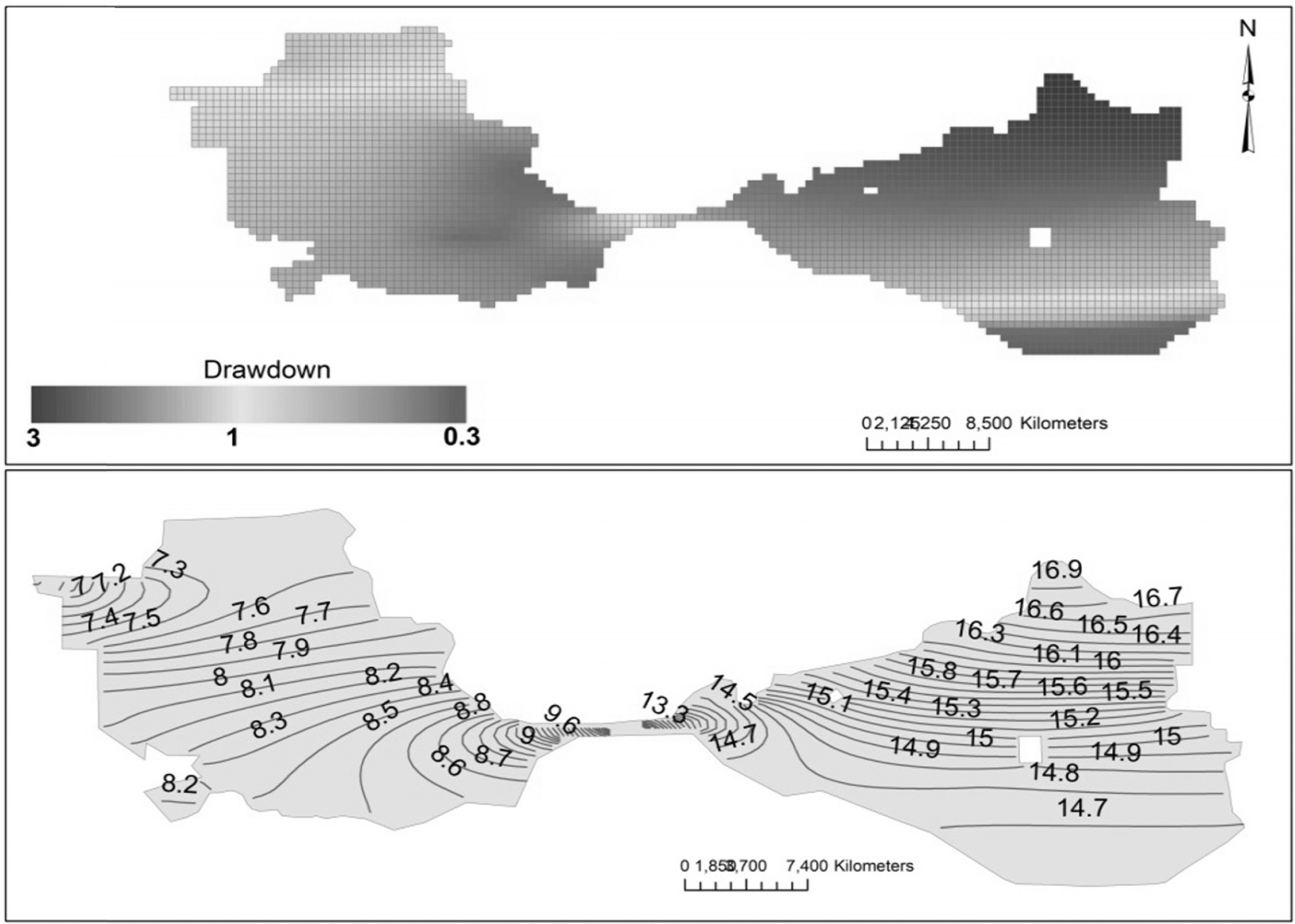
|
Fig. 6 (I) Simulated drawdown (m) and (II) simulated hydraulic heads (m a.s.l.) for irrigation unit 16. |
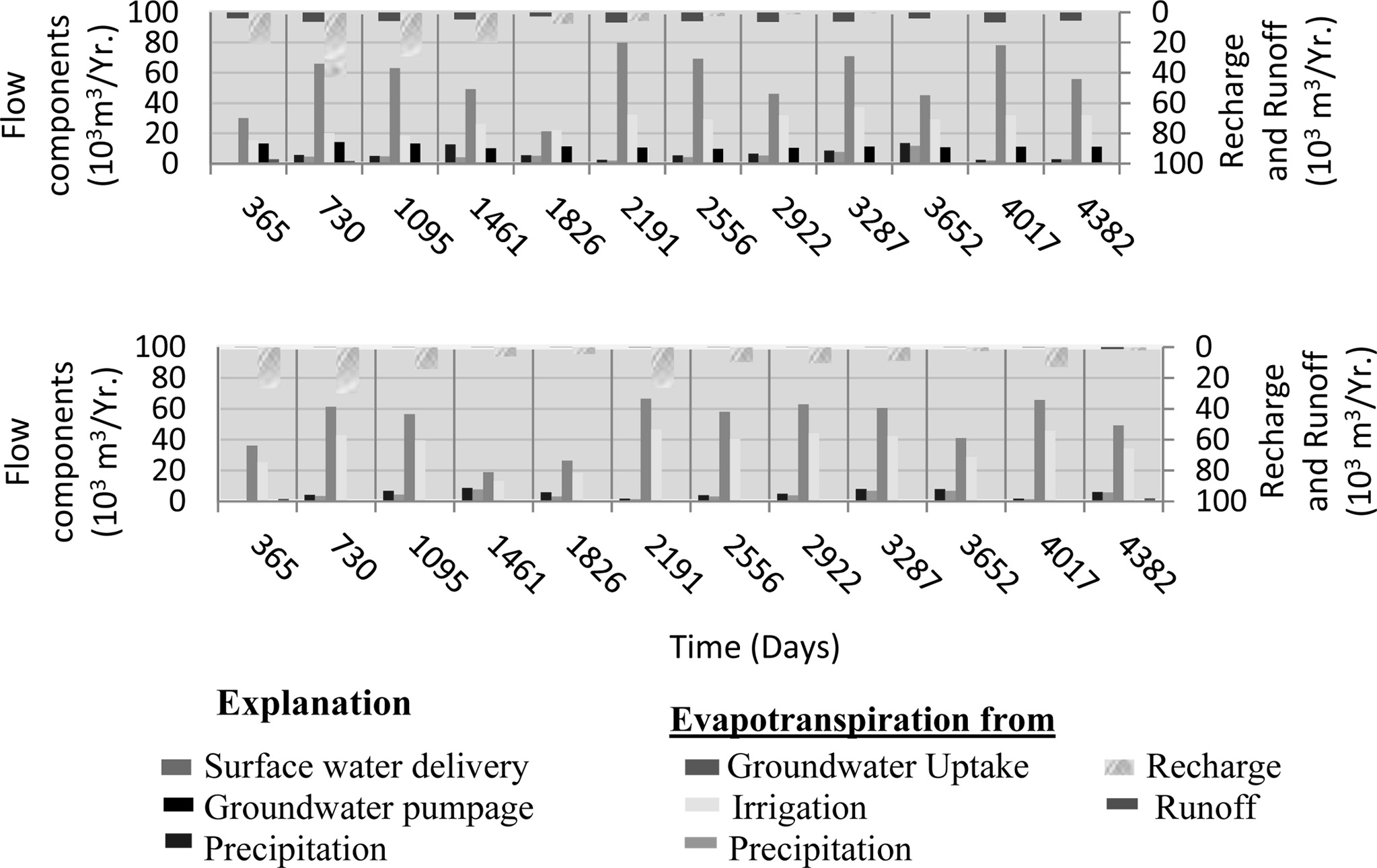
|
Fig. 7 Farm delivery components and the inflows and outflows for two water-balance subregions (WBS1, top, and WBS3, bottom) from 1995 to 2006. Recharge and runoff, refer the second axis. |

|
Fig. 8 Graph showing the percentages of total Landscape (LS) inflows and outflows for two water-balance areas from 1995 to 2006 as part of conjunctive use simulated by MF-FMP. |
The
sustainability of water resources in part depends on the ability to monitor our
aquifers and to simulate and analyze all the components of complex hydrologic
systems, including groundwater, surface water, and landscape components. A
regional groundwater flow model on irrigation unit 16 was developed and
calibrated against available groundwater level observations and measured
agricultural pumpage, which converges to a solution with a small water balance
error. A conceptual model of the study area with two layers is defined to
identify the effects of agricultural activities on groundwater level and
groundwater recharges. The main conclusions drawn from the model are:
• The source of water to the groundwater
reservoirs in the study area is through net-agricultural recharge, which
amounts in total to 97.84*104 m3. The study area
experienced high groundwater evaporation amount about 123.16*104 m3.
The average negative change in storage is indicating that outgoing groundwater
from the study area is higher than incoming groundwater (recharge) which shows
aquifer depletion.
• Calibration of the model using the
available observations of groundwater levels gives a relatively good fit with
an RMS of 0.02 m and a normalized RMS of 2.1% with a correlation
coefficient of 0.97. The reported agricultural pumpage located at WBS1 and WBS2
was used as an additional calibration target that, the simulated pumpage is
within the range of uncertainty of the reported pumpage. The average annual differences
(reported minus simulated) for total agricultural were -671 m3/yr.
and -570 m3/yr. Which represents average differences of about
-0.54 and -0.49 percent of the reported agricultural pumpage for WBS1 and WBS2
respectively.
• The simulated potentiometric level shows a
hydraulic head range from 19.6 m in some areas to less than 10 m in
the lowlands. Groundwater flows toward the Gulf of California.
• The simulated MF-FMP inflow-outflow
analysis shows that the WBS1, which constitutes the eastern part of the
modeling area, receives comparably more runoff and after the year 1999, lesser
recharge than WBS3, which constitutes the western part of the modeling area.
• The simulated component for WBS 1 and WBS
3 confirmed that groundwater recharge is derived from agricultural supplies
nothing that the precipitation is lost due to evapotranspiration.
• The landscape budget for WBS1 and WBS 3
shows evapotranspiration (ET) from groundwater uptake are about 3% and 4% and
recharge to the groundwater is about 19% and 21% respectively.
• The modeling effort on irrigation unit 16
shows that the aquifer was drawn downed up to 3 m in some areas and
drawdown was higher in the northeastern region than western regions.
• The MF-FMP modeling on selected WBS showed
that recharge to the aquifer occurring in response to irrigation supplies because
there is little precipitation exists; which eventually lost before reaching to
the aquifer. Routed surface water delivery, pumping delivery for irrigation and
evaporation from groundwater uptakes are the main landscape inflow components
for eastern areas (WBS1) in addition to precipitation. Crop consumptive use in
the western side (WBS3) is supplemented by the routed surface water delivery,
evaporation from groundwater and precipitation.
The authors
believe that these results are very important for future conjunctive water
resources management in the region and this work is the first and unique
example in the region which might be a guide for development of the integrated
hydrologic model using MF-FMP for whole irrigation district 014 which is in
need and other agricultural regions which seek integrated modeling with a
similar geological environment. Monitoring of diversion rates from the Colorado
River to each farm on a better scale as a function of time and detail database
on agricultural crops are recommended for future model development.
The authors
would like to acknowledge Autonomous University of Baja California (UABC),
Agencia Mexicana de Cooperación Internacional para el Desarrollo de la Secretaria
de Relaciones Exteriores del Gobierno Mexicano, and Arba Minch University for
all type of support they provided.
- 1. Barragan, R. M., P. Birkle, E. Portugal M., V. M. Arellano G., and J. Alvarez R., 2001, Geochemical survey of medium temperature geothermal resources from the Baja California peninsula and Sonora, Mexico, Journal of Volcanology and Geothermal Research, 110, 101-119, PII: S0377-0273(01)00205-0.
-

- 2. Bushira, K.M., Ramirez-Hernández, J., and Zhuping, S., 2017, Surface and groundwater flow modeling for calibrating steady state using MODFLOW in Colorado River Delta, Baja California, Mexico, Journal of Modeling earth systems and Environment.no. 3, 815-824.
-

- 3. Chavez, R.E., Lazaro-Mancilla, O., Campos-Enriquez, J.O., and Flores-Marquez, E.L., 1999, Basement topography of the Mexicali Valley from spectral and ideal body analysis of gravity data, Journal of South American Earth Sciences, 12, 579-587, PII: S0895-9811(99)00041-3.
-

- 4. Feirstein, E., Zamora-Arroyo, F., Vionnet, L.y., Maddock, T. 2008, Simulation of groundwater conditions in the Colorado River Delta, Mexico. Tesis de Maestría. Tucson, AZ.
- 5. Gastil, R.G., Krummenacher, D., and Minch, J.A., 1979, The record of Cenozoic volcanism around the Gulf of California, Geological Society of America Bulletin, 90, 839-857.
-

- 6. Harshbarger, J.W., 1971, Overview report of hydrology and water development, Colorado Delta, United States and Mexico, Preliminary Report PR-235-77-2, Prepared for International Boundary and Water Commission United States Section, Tucson AZ, USA.
- 7. Harbaugh, A.W., Banta, E.R., Hill, M.C., and McDonald, M.G., 2000, MODFLOW-2000, U.S. Geological Survey modular ground-water model-User guide to modularization concepts and the ground-water flow process: U.S. Geological Survey Open-File Report 2000-92, 121 p., http://pubs.er.usgs.gov/publication/ofr200092.
-

- 8. Harbaugh, A.W., 2005. MODFLOW-2005: the U.S. Geological Survey modular ground-water model-the ground-water flow process: U.S. Geological Survey Techniques and Methods 6-A16, variously paginated, http://pubs.er.usgs.gov/publication/tm6A16.
-

- 9. Hillel, D. (2008) Soil chemical attributes and processes, Soil in the environment: crucible of terrestrial life, Chapt 10. Academic Press, San Diego, pp. 135-150.
-

- 10. Hill, B.M., 1993, Hydrogeology, numerical model and scenario simulations of the Yuma area groundwater flow model Arizona, California, and Mexico, Modeling Report no. 7, Arizona Department of Water Resources, Phoenix AZ, USA.
- 11. Mock, P.A., Burnett, E.E., and Hammett, B.A., 1988, Digital computer model study of Yuma area groundwater problems associated with increased river flows in the lower Colorado River from January 1983 to June 1984, Arizona Department of Water Resources Open-File Report No. 6, Phoenix AZ, USA.
- 12. Niswonger, R.G., Prudic, D.E., and Regan, R.S., 2006. Documentation of the Unsaturated-Zone Flow (UZF1) Package for modeling unsaturated flow between the land surface and the water table with MODFLOW-2005. U.S. Geological Survey Techniques and Methods 6-A19.
-

- 13. Niswonger, R.G. and Prudic, D.E., 2005, Documentation of the streamflow-routing (SFR2) package to include unsaturated flow beneath streams-A modification to SFR1: U.S. Geological Survey Techniques and Methods 6-A13, 51 p., http://pubs.er.usgs. gov/publication/tm6A13.
-

- 14. Olmsted, F., Loeltz, O.y., and Irelan, B., 1973, Geohydrology of the Yuma Area, Arizona, and California, Geological Survey Professional Paper 486-H, United States Government Printing Office Washington, DC.
-

- 15. Pacheco, M., Martin-Barajas, A., Elders, W., Espinosa-Cardena, J.M., Helenes, J., and Segura, A., 2006, Stratigraphy and structure of the Altar basin of NW Sonora: implications for the history of the Colorado River Delta and the Salton trough, Revista Mexicana de Ciencias Geologicas, 23(1), 1-22.
- 16. Portugal, E., Izquierdo, G., Truesdell, A., and Alvarez, J., 2005, The geochemistry and isotope hydrology of the Southern Mexicali Valley in the area of the Cerro Prieto, Baja California (Mexico) geothermal field, Journal of Hydrology, 313, 132-148.
-

- 17. Puente, I.C. and A. De La Pena L., 1979, Geology of the Cerro Prieto geothermal field, Geothermics, 8, 155-175.
-

- 18. Richard B. Winston. 2009, ModelMuse-A Graphical User Interface for MODFLOW-2005 and PHAST.
- 19. Roman-Calleros, J. and Ramírez-Hernández, J., 2003. Interdependent Border Water Supply Issues: The Imperial and Mexicali Valleys. In: Michel S. (Eds.), The U.S.-Mexican border environment: Binational water management planning, San Diego State University Press, San Diego, California, Chap: 2, pp. 95-144.
- 20. Rodríguez-Burgueño, J., 2012, Modelación geohidrológica transitoria de la relación acuífero-río de la zona FFCC -vado Carranza del río Colorado con propósito de manejo de la zona riparia., Master Eng., Universidad Autónoma de Baja California, Mexicali, B.C.
- 21. Schmid, W. and Hanson, R.T., 2009a, Appendix 1, Supplemental Information-Modifications to Modflow-2000 Packages and Processes. In Ground-Water Availability of California¡¯s Central Valley., ed. C.C. Faunt, 213-225. U.S. Geological Survey Professional Paper 1766.
- 22. Sawlan, M.G. and Smith, J.G., 1984, Petrologic characteristics, age, and tectonic setting of Neogene volcanic rocks in northern Baja California Sur, Mexico, in Frizzell, V.A., Jr., Geology of the Baja California Peninsula, Society of Economic Paleontologists and Mineralogists, 39, 239-251.
- 23. Schmid, W. and Hanson, R.T., 2009b. The Farm Process Version 2 (FMP2) for MODFLOW-2005 – Modifications and Upgrades to FMP1. U.S. Geological Survey Techniques in Water Resources Investigations, Book 6, Ch. A32.
-

- 24. Schmid, W., 2004, A Farm Package for MODFLOW-2000: Simulation of Irrigation Demand and Conjunctively Managed Surface-Water and Ground-Water Supply. Ph.D. Dissertation. Department of Hydrology and Water Resources, the University of Arizona.
- 25. Schmid, W., Hanson, R.T., Maddock III, T.M., and Leake, S.A., 2006a. User¡¯s guide for the Farm Package (FMP1) for the U.S. Geological Survey¡¯s modular three-dimensional finite-difference groundwater flow model, MODFLOW- 2000. U.S. Geological Survey Techniques and Scientific Methods Report Book 6, Chapter A17.
-

- 26. Schmid, W., Hanson, R.T., and Maddock III, T.M., 2006b, Overview and Advances in the Farm Process for MODFLOW-2000. MODFLOW and MORE 2006. Managing Groundwater Systems-Conference Proceedings, 23-27.
- 27. Smith, J.T., 1984, Miocene and Pliocene mar~ne mollusks and preliminary correlations, Viscaino Peninsula to Arroyo La Purisima, northwestern Baja California Sur, Mexico, in Frizzell, V.A., Jr., Geology of the Baja California Peninsula: Society of Economic Paleontologists and Mineralogists, 39, 197-217.
- 28. Sykes, G.G., 1935, The Colorado Delta, Carnegie Institution of Washington, Washington DC, USA.
 This Article
This Article
-
2019; 24(5): 17-30
Published on Oct 31, 2019
- 10.7857/JSGE.2019.24.5.017
- Received on Aug 16, 2019
- Revised on Sep 2, 2019
- Accepted on Oct 10, 2019
 Services
Services
- Abstract
1. introduction
2. mf-fmp features
3. materials and methods
4. results and discussion
5. discussion
6. conclusions
- Acknowledgements
- References
- Full Text PDF
Shared
 Correspondence to
Correspondence to
- Kedir Mohammed Bushira
-
Corresponding author: Department of Water Resources and Irrigation Engineering, P. o. Box 21, Arba Minch University, Ethiopia
- E-mail: kdrmohammed@gmail.com/kedir.mohammed@amu.edu.et






